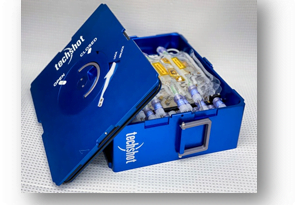Metal Organic Frameworks
Contents
Metal Organic Frameworks: Structure, Principles and Applications
Metal-Organic Frameworks (MOFs) represent one of the most revolutionary classes of porous materials in modern chemistry, recognized by the 2025 Nobel Prize in Chemistry. These crystalline compounds have emerged as versatile platforms for addressing critical challenges across multiple industries, from clean energy storage to advanced drug delivery systems. Synthesis and structural assembly of a chromium-based metal-organic framework using terephthalic acid as organic linker at 220 °C, forming a super tetrahedron cluster-based porous framework
Definition and Basic Structure
Metal-Organic Frameworks are three-dimensional crystalline materials composed of metal ions or clusters (nodes) connected by organic ligands (linkers) through coordination bonds. The organic ligands, sometimes referred to as “struts” or “linkers,” bridge metal centers to form extended networks with well-defined pores and cavities. Common examples include 1,4-benzenedicarboxylic acid as an organic linker.
The fundamental building blocks of MOFs consist of:
Metal nodes: Single metal atoms or clusters that act as connection points
Organic linkers: Bridging molecules that connect the metal centers
Secondary Building Units (SBUs): Metal clusters that provide specific geometries and connectivity patterns
Principles Behind MOF Formation
Coordination Chemistry Foundation
The formation of MOFs relies on coordination bonding principles where metal centers accept electron pairs from donor atoms in organic ligands. These coordination bonds are strong yet reversible, allowing for controlled assembly and potential structural modifications. The coordination number – the number of ligands attached to each metal center – varies based on the metal’s electronic configuration and the ligands’ properties.
Reticular Chemistry Approach
MOF synthesis follows the principles of reticular chemistry, which focuses on creating extended networks through predictable geometric arrangements. The geometric principle involves maintaining rigid shapes of metal-containing units, leading to preferred topologies that enable permanent porosity. This systematic approach allows researchers to design MOFs with targeted properties by selecting appropriate metal-linker combinations.
Structural Control Factors
Several key factors determine MOF structure and properties:
Metal coordination geometry: Different metals adopt various coordination numbers and geometries
Linker flexibility: Rigid vs. flexible organic ligands offer different degrees of structural freedom
Reaction conditions: Temperature, pressure, solvent choice, and pH significantly influence the final structure
Counterions and modulators: These influence supramolecular structure and pore characteristics
Synthesis Methods
Solvothermal Synthesis
The most common MOF synthesis method involves dissolving metal salts and organic linkers in solvents, then heating under controlled conditions. This “classic” approach typically requires high temperature and pressure but produces well-crystallized materials with defined structures. Hydrothermal synthesis uses water as the solvent, while solvothermal methods employ various organic solvents.
Alternative Synthesis Methods
Modern MOF production has diversified to include several innovative approaches :
Mechanochemical synthesis involves grinding solid reagents, sometimes with minimal solvent. This environmentally friendly method operates at room temperature, uses little to no organic solvent, and can be performed on large scales efficiently.
Microwave-assisted synthesis reduces reaction times while maintaining crystallinity and enabling rapid MOF formation.
Sonochemical methods utilize ultrasonic frequencies to create cavitation bubbles, generating local hot spots that activate solid reagents and promote rapid MOF formation.
Electrochemical synthesis offers precise control over metal ion release and can produce MOFs under ambient conditions with reduced environmental impact.
Key Properties and Characteristics
Exceptional Porosity
MOFs exhibit extraordinarily high surface areas, often exceeding thousands of square meters per gram. For example, MOF-5 demonstrates a surface area of 2200 m²/g, approximately 15 times that of human lungs. The pore volume can reach up to 90% of the crystalline volume, providing ample space for guest molecule accommodation.
Tunable Pore Architecture
Unlike traditional porous materials, MOF pore sizes can be precisely controlled by selecting appropriate linkers and metal centers. Pore diameters typically range from a few angstroms to several nanometers, with some reaching up to 98 Å. This tunability enables size-selective applications and customized molecular recognition.
Chemical Versatility
The modular nature of MOFs allows incorporation of various functional groups, imparting diverse properties such as:
Catalytic activity from specific metal centers
Magnetic properties from transition metal incorporation
Luminescence from appropriate metal-ligand combinations
Biocompatibility through careful material selection
Structural Flexibility
Some MOFs exhibit “breathing” behavior, where the framework expands, contracts, or undergoes structural changes in response to temperature, pressure, or guest molecules. This dynamic behavior enables applications in gas storage, molecular sensing, and controlled release systems.
Applications
Gas Storage and Separation
MOFs show exceptional promise for storing and separating gases due to their high surface areas and tunable pore structures. Hydrogen storage applications target fuel cell vehicles and stationary energy systems, with MOFs offering high uptake capacities and controllable adsorption kinetics. Methane storage for vehicular natural gas systems benefits from MOFs’ compact and efficient storage capabilities.
Carbon capture and storage represents a critical application for climate change mitigation, where MOFs selectively capture CO₂ from industrial flue gases. Companies like Svante have demonstrated commercial-scale CO₂ capture using zinc-based CALF-20, removing approximately 1 tonne of CO₂ per day from cement plant emissions.
Catalysis Applications
The high surface area, well-defined active sites, and structural tunability make MOFs excellent heterogeneous catalysts. They can function as single-site catalysts with spatially separated active centers, enabling precise control over reaction selectivity and efficiency. MOF catalysts have shown effectiveness in petrochemical refining, pharmaceutical synthesis, and environmental cleanup processes.
Drug Delivery Systems
MOFs have emerged as promising drug delivery carriers due to their biocompatibility, high drug loading capacity, and controlled release properties. The porous structure allows encapsulation of various therapeutic molecules, while surface functionalization enables targeted delivery to specific tissues or cells.
Stimuli-responsive MOFs can release drugs in response to specific environmental conditions such as pH changes, making them ideal for targeted cancer therapy. Research has demonstrated successful delivery of challenging drugs including busulfan, doxorubicin, and antiviral compounds.
Energy Storage Applications
MOFs show significant potential as electrode materials for batteries and supercapacitors. Their high surface area, tunable pore structure, and ability to incorporate redox-active sites make them attractive for electrochemical energy storage. However, low electrical conductivity remains a challenge, leading to the development of MOF composites and derivatives with enhanced conductivity.
Sensing and Detection
The selective adsorption properties and structural responsiveness of MOFs enable their use as chemical sensors. They can detect minute concentrations of gases or chemicals, making them valuable for industrial safety, healthcare diagnostics, and environmental monitoring. MOF-based sensors have been developed for pharmaceutical drug detection, offering rapid, sensitive, and selective electrochemical sensing capabilities.
Water Purification
MOFs can act as efficient filters for water treatment, removing contaminants through selective adsorption. Their ability to capture heavy metals, organic pollutants, and pathogens contributes to clean water initiatives and environmental remediation efforts.
Current Challenges and Limitations
Stability Issues
Many MOFs suffer from poor stability under practical conditions, particularly in the presence of water, acids, or bases. Large-pore MOFs are especially vulnerable to framework collapse upon desolvation. The poor stability of early MOFs like MOF-5, which rapidly decomposes in humid environments, has highlighted the need for more robust materials.
Scale-up and Manufacturing Challenges
Transitioning from laboratory synthesis to industrial production faces significant obstacles. The high cost of raw materials, complex synthesis requirements, and need for specialized equipment create barriers to commercialization. Current MOF production costs remain high compared to other solid adsorbents, though costs decrease with scale-up.
Conductivity Limitations
Low electrical conductivity seriously hinders MOF applications in energy storage and electronic devices. This limitation has driven research into MOF composites, derivatives, and conductive MOF designs to overcome conductivity barriers.
Processing and Forming Challenges
Converting MOF powders into practical forms (pellets, films, membranes) without compromising their properties remains challenging. The forming process must preserve surface area and porosity while providing mechanical stability for real-world applications.
Future Prospects and Opportunities
Market Growth and Commercialization
The global MOF market is projected to grow from $459.6 million in 2024 to $949.2 million by 2029, representing a compound annual growth rate of 15.6%. Approximately 50 companies worldwide are now focused on MOF commercialization, with many targeting CO₂ capture applications.
Technological Integration
Integration of MOFs with artificial intelligence and machine learning accelerates material discovery by enabling rapid screening of optimal structures for specific applications. High-throughput computational methods and automated synthesis platforms are transforming MOF research from trial-and-error approaches to rational design strategies.
Emerging Applications
Future MOF applications continue to expand into new domains including:
Biomedical imaging and theranostics combining therapy and diagnostics
Flexible electronics leveraging conductive MOF properties
Advanced separation technologies for industrial processes
Environmental remediation addressing pollution and climate challenges
Design Innovations
Research directions focus on developing MOFs with enhanced stability, conductivity, and multifunctionality. Strategies include defect engineering, dimensional reduction to 2D structures, and creation of multivariate MOFs incorporating multiple functional components.
Conclusion
Metal-Organic Frameworks represent a transformative class of materials that bridges molecular and solid-state chemistry principles. Their unique combination of high porosity, structural tunability, and chemical versatility has opened unprecedented opportunities across multiple disciplines. While challenges related to stability, scalability, and conductivity persist, ongoing research and technological advances continue to address these limitations.
The recognition of MOF pioneers with the 2025 Nobel Prize in Chemistry underscores the significance of this field and its potential to address global challenges in energy, environment, and healthcare. As the field matures from fundamental research toward practical applications, MOFs are positioned to play crucial roles in developing sustainable technologies for the future.
The success of MOF commercialization will depend on continued collaboration between researchers, engineers, and industry partners to overcome technical barriers and develop cost-effective manufacturing processes. With growing market interest and technological integration, MOFs are set to transition from laboratory curiosities to industrial game-changers, contributing to a more sustainable and innovative future.


